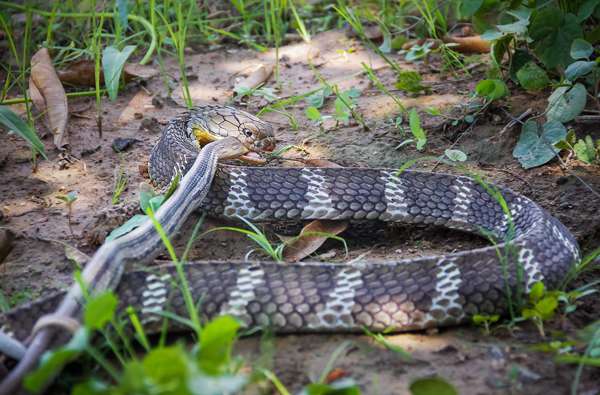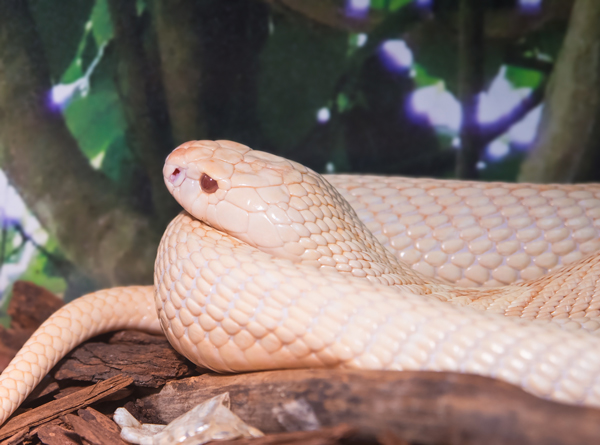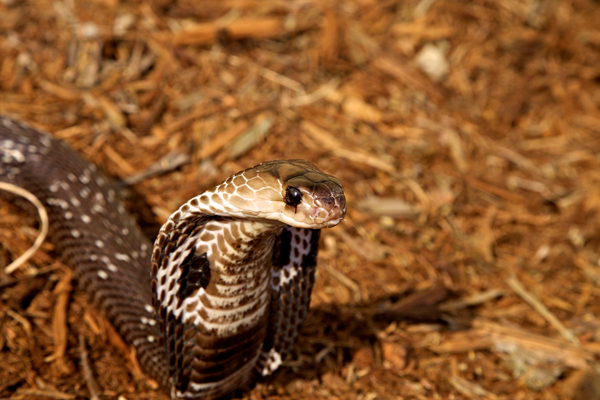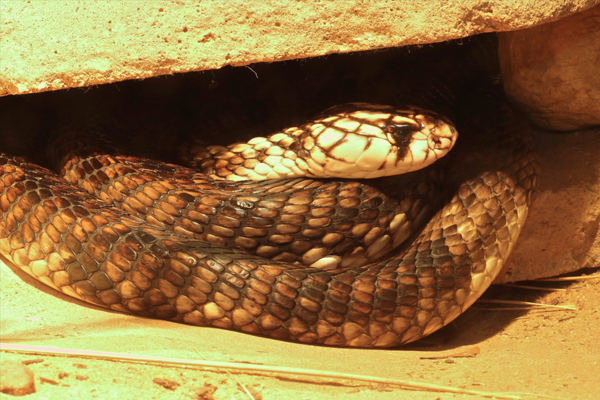It’s impossible not to find cobras fascinating!
Nearly everyone, whether or not they are knowledgeable about reptiles, recognizes a cobra. This is due primarily to the fact that cobras display one of the most—if not the most—iconic snake poses: the rearing, hooded display. For proof of this, look no further than ancient Egypt. In ancient Egyptian culture, the Uraeus was a hooded cobra symbol used to represent sovereignty, royalty, deity, or divine authority.
Cobras belong to the family Elapidae, the members of which are characterized by proteroglyph dentition, meaning they have two short, fixed fangs in the front of the mouth, which channel venom into their prey like hypodermic needles.
This article will provide a brief introduction to several cobra species, including some that are commonly available in the reptile trade (at least where venomous reptiles can be kept legally), as well as some discussion on some of the defining characteristics of cobras. Naturally, only extremely experienced keepers who have training with elapids, including cobras, should even think about maintaining these amazing snakes in captivity.
King Cobra

13672071/Thinkstock
The king cobra is not considered to be a true cobra species, such as the other cobras in the Naja genus; instead, it belongs to its own genus, Ophiophagus.
The king cobra (Ophiophagus hannah) is the longest venomous snake species, with adults ranging from about 8 to 18 feet in length. They may live up to 25 years.
Kings are sexually dimorphic, and the males reach a larger size compared to the females. The longest known specimen found in the wild was about 15.7 feet and weighed about 26 pounds. Despite their size, king cobras are extremely fast and agile, and they are the source of inspiration for many myths and legends throughout their range, which extends throughout Southeast Asia, including Myanmar, Cambodia, Laos, Thailand, Vietnam, Malaysia, Philippines and Indonesia. Their longitudinal distribution extends from India in the west to southern China in the east, and in the mountainous regions of India, king cobras have been known to live in altitudes exceeding 6,500 feet above sea level. Their home ranges can extend up to about three miles.
The king cobra is not considered to be a true cobra species, such as the other cobras in the Naja genus; instead, it belongs to its own genus, Ophiophagus. Its genus name was derived based on its proclivity for eating other snakes, and it is known to attack larger snakes, including pythons. Captive king cobras can be difficult to switch from eating snakes to rodents, and some keepers will feed them ball pythons, which they seem to find quite delectable.
Morphologically, the king cobra has a larger head and more narrow hood compared to other cobra species. A key to identifying them is the presence of a pair of large scales, known as occipitals, located at the back of the top of the head. These are behind the usual “nine-plate” arrangement typical of colubrids and elapids, and are unique to the king cobra.
Neonatal king cobras look much different compared to older animals. They have a distinct black and tan to orange alternating chevron banding pattern along their bodies. When they mature, most adult specimens lose the banding pattern and exhibit a more overall olive coloration.
In spite of its fearsome reputation, the king cobra is generally a shy snake, avoiding confrontation with humans as much as possible. It is one of the few species of reptiles to have its genome characterized. Much research has gone into the characterization of its venom and its use in biomedical applications such as pain medications and antivenin development. King cobras posses a highly neurotoxic venom, the main constituent of which is a postsynaptic neurotoxin, and a single bite can deliver up to 500 mg of venom. Its bite is considered more serious than those from other cobra species because a greater volume of venom is injected, as well as a more rapid onset of neurotoxic symptoms. That said, bites from king cobras are rare.
Monocled Cobra

eans/Thinkstock
Monocled cobras can reach lengths of 4 to 5 feet.
The monocled cobra (Naja kaouthia) is one of the most readily recognized cobra species because of the unique, O-shaped pattern on its dorsal hood. Its range extends from southeast to southern Asia, including India, China, Vietnam, Cambodia, Malaysia, Bangladesh, Thailand (where they are responsible for the greatest number of human fatalities resulting from snake envonmation), Nepal, Laos and Myanmar. Monocled cobras can inhabit a wide range of habitats, including grassland, forest, scrubland, and in or around human-inhabited areas. Often, they are found in agricultural zones such as rice paddies.
Monocled cobras exhibit biogeographical variation between their venoms, and it has been documented that different toxicities exist between Malaysian, Thailand and Vietnam monocled cobras. Malaysian specimens tend to have a greater number of neurotoxins compared to Thai and Vietnam monocled cobras, while the latter possess more cytotoxic venoms, which are predominantly myotoxic and cardiotoxic.
On average, monocled cobras can reach lengths of 4 to 5 feet, though there are reports of specimens up to about 7½ feet. Typically, they live in small rodent burrows and feed on small mammals, rodents, snakes and amphibians. Captive monocled cobras can be maintained on rodents, both frozen and live.
Several different morphs of monocled cobras are available in the reptile trade, including albinos, red-eyed leucistic, orange pastel, granite, Albino T- (Sunset), Albino T+ (Sunglow).
Indian Cobra

Anthony Wilson/Thinkstock
Adult Indian cobras grow to about 4 to 7 feet.
The Indian cobra (Naja naja) is one of the most dangerous cobra species in India, and is responsible for about 10,000 envenomations per year. It is considered one of the “Big Four” snakes of southern Asia, which are responsible for the majority of human deaths by snakebite (the other three are the common krait, Bungarus caeruleus; Russell’s viper, Daboia russelii; and the saw-scaled viper, Echis carinatus).
Indian cobras extend from Pakistan throughout India and Sri Lanka to southeast Asia and Malaysia. Although their coloration is quite variable throughout their range, they have a very distinct dorsal hood pattern; most have a v-shaped “spectacle” marking on the back of the hood.
Adult Indian cobras measure about 4 to 7 feet in length and feed primarily on rodents. Individuals are often encountered in villages because of the associated abundant prey items, although the cobra’s natural habitat includes open fields, forest edges, agricultural land and wetlands.
The Indian cobra is the species typically used by snake charmers in India. In Hindu mythology, it is considered a powerful god, and it remains greatly respected and feared in Hindu culture. Rudyard Kipling featured a pair of Indian cobras in his famous short story Rikki-Tikki-Tavi.
Egyptian Cobra

NajaShots/Thinkstock
Egyptian cobras grow to about 8 feet in length.
At about 8 feet in length, the Egyptian cobra (N. haje) is the second-largest cobra species on the African continent, after the forest cobra (discussed next). Egyptian cobras range across most of northern Africa, in the northern Saraha, through the savannahs of west Africa to the southern Sahara, south to the Congo basin and east to Kenya and Tanzania. Specimens may also be found in southern areas of the Arabian Peninsula. The species thrives in savannah and arid semi-desert regions of Africa where some water and vegetation is available.
The Egyptian cobra gained notoriety in the U.S. in 2011, when Mia, a resident of the Bronx Zoo, escaped. She was eventually discovered in the reptile house.
Forest Cobra
The forest cobra (N. melanoleuca) is considered the largest true cobra species, and specimens have been documented at up to 10 feet in length. It occurs mainly in western and central Africa, where it can be found from Senegal in the west to Angola, western Kenya, Uganda and Rwanda in the east. It can also be found in some parts of south Africa.
As its common name indicates, the forest cobra lives primarily in forest or woodlands, and it is the only cobra species found in such areas in Africa. Due to its ecological niche, humans do not often encounter forest cobras, and the species is one of the least frequent causes of snakebites in Africa (it possesses a primarily neurotoxic venom). It is primarily a diurnal species, and it exhibits some arboreal tendencies due to its natural habitat.
Cape Cobra
Regarded as one of the most dangerous species in all of Africa, the Cape cobra (N. nivea) is a golden brown/black to yellow-colored cobra species that primarily inhabits southern Africa, particularly the countries of South Africa, Namibia, Lesothos, and part of Botswana. It has one of the smallest geographic distributions of all the African cobra species. It is a medium-sized cobra measuring approximately 4 to 5 feet in length.
The Cape cobra is considered the most dangerous of the Africian species because it ventures into human-inhabited areas to escape the heat or seek prey items.This increases the species’ interactions with humans. Other than humans, its main predators include the honey badger, meerkat, and the mongoose, all of which are thought to have evolved a resistance or decreased sensitivity to the Cape cobra’s predominately neurotoxic and cardiotoxic venom.
Here’s Venom In Your Eye
Spitting cobras (Naja spp.) are unique in their utilization of venom and venom delivery system apparatus. Two groups comprised of Asiatic and African species have independently evolved a specialized defensive behavior to ward off potential predators: the ability to project venom from their fangs.
The venom is generally aimed at the eyes of the target, and if even a small quantity of venom contacts the eye, it produces intense pain, disruption of the cornea, and swelling of the eyes. Some cobras can project venom up to nine feet!
Spitting cobra fang anatomy is different compared to other cobra species, as they possess a more forward and circular opening to their fangs compared to other cobras. This specialized structure allows the venom stream expelled by spitting cobras to travel forward, rather than downward.
Amazingly, when spraying, spitting cobras are able to match venom distribution to the size of the target, regardless of distance. These snakes are very unlikely to bite as a defensive behavior; however, envenomations from bites have been reported.
Seven species of African spitting cobras exist today. They are Ashe’s spitting cobra (N. ashei), the Mali cobra (N. katiensis), Mozambique spitting cobra (N. mossambica), Zebra spitting cobra (N. nigricincta), black-necked spitting cobra (N. nigricollis), Nubian spitting cobra (N. nubiae), and the red spitting cobra (N. pallida).
The seven species of Asiatic spitting cobras are the Mandalay spitting cobra (N. mandalayensis), Palawan spitting cobra (N. miolepis), Philippine spitting cobra (N. philippinensis), Samar cobra (N. samarensis, also known as the Peter’s cobra), Indochinese spitting cobra (N. siamensis, also known as the black and white or Thai spitting cobra, Javan spitting cobra (N. sputatrix), and the equitoral spitting cobra (N. sumatrana).
The two species of spitting cobras which are the most common in the reptile trade are the Indochinese and the red spitting cobras. The coloration of N. siamensis is variable, from gray to brown to black, with white spots or stripes. The white patterning can be so diffuse, it can cover the entire snake. Adults have a rather thick body and average between 2.9 to 3.9 feet. The species is native to southeast Asia, including Thailand, Cambodia, Vietnam, Laos, and Myanmar. Specimens have been found in a range of habitats, including lowlands, hills, plains, and woodlands.
The red spitting cobra is a medium-sized cobra that may reach a length of up to 4 feet. Originally, it was thought to be a subspecies of the Mozambique spitting cobra, but is now considered its own species. It is favored by venomous snake keepers due to its coloration, which is typically a salmon to red color with black banding.
This cobra is primarily found in east Africa, including Somalia, southern Egypt, Ethopia, Tanzania, Kenya and Sudan. There is much variation to the coloration throughout its range, and animals from Kenya and northern Tanzania exhibit an orange to red coloration with a very broad black throat band.
When interacting with any spitting species of cobras, it is, naturally, imperative to wear protective eye gear, or even an entire face shield, to prevent any venom from entering your eyes if the animal decides to spit venom.
Captive Cobras
As mentioned, only the most experienced keepers should attempt to keep cobras. Novice keepers should never consider doing so, as it is possible for keepers to be killed by these snakes. That said, they do make fascinating captives.
Species-specific husbandry requirement are determined based on each animal’s natural history and environment. A significant amount of research should be performed prior to acquiring any cobra species, including knowing your local laws and antivenin availability. It is also a good idea to meet with the staff at your local medical facility.
Cobras are typically very active snakes that require a fair amount of space. Housing them can be accomplished using a variety of methods, including Vision cages, rack systems, or custom-built enclosures. Obviously, one of the primary concerns when housing any venomous snake is making sure the enclosure is secure to prevent any escapes.
Sean M. Perry, DVM, is a veterinarian practicing and pursuing a Ph.D at Louisiana State University School of Veterinary Medicine, with a special interest in reptile medicine and surgery. His research focuses on developing artificial reproductive technologies in endangered reptile species and advancing emergency and critical care medicine in reptiles.


